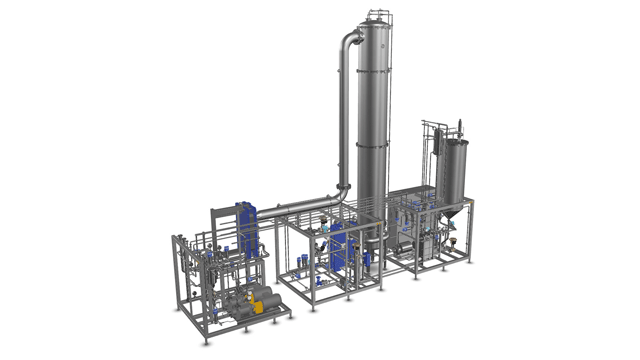Yeast management systems
Alfa Laval has a broad range of modules for yeast management that help control variables and minimize inconsistencies. Each yeast management module for gentle and consistent handling of yeast, which leads to consistent fermentation performance time and time again.
Brewery yeast management for consistently high productivity and product quality
- Provides optimum conditions for yeast growth and fermentation and minimizes surplus yeast volume
- Offers automatic pitching (both batch and continuous)
- Has in-line viable yeast measurement
- Enables good harvesting and storage practices to extend yeast use and spread cost of culture over a number of brews
Service
Food system services
Alfa Laval Food system services help extend the performance of your food systems by maximizing the performance of your processes. This enables you to:
- Continually improve your operations to maintain competitive advantage
- Focus on uptime, optimization and availability
- Maximize return on investment throughout the life cycle of your food systems
You may also be interested in our brewery solutions 3D/VR models
FAQs
In a small brewery, how long can yeast be stored in containers at 4°C?
At Alfa Laval, we recommend storing yeast in containers at 4°C for no more than a week. Read more about craft brewing here.
Do different yeasts react differently to propagation? Without agitation?
The main function of agitation is to ensure the distribution of the air into the wort. Whether an agitator is required for proper yeast propagation depends largely on the volume of the tank.
Does yeast benefit more from aeration by pure oxygen, or can filtered ambient air be used? I am thinking about developing and conditioning a yeast specific to the air in my region.
Pure oxygen is normally not used in a propagation plant due to the limited amount of oxygen required for propagation. The use of filtered ambient air may be more interesting when conditioning baker’s yeast.
How is the agitator shaft fitted through the tank to ensure sanitary connection?
Specially designed for hygienic applications, The agitator shaft is installed into a top flange. See the video about cleaning or contact Alfa Laval for more information.
You talked about hydrogenation. What is the medium used to hydrate dried yeast in the propagator? Is this just water at room temperature, do you add other nutrients?
Yeast hydrogenation is usually accomplished using clean process water or sterile wort.
What is the rotation recommended for homogenization? For Cleaning-in-Place (CIP)?
For homogenization, the rotation during propagation and storage is approximately 90-100 rpm. During CIP, the rotation is generally 50 to 100 rpm.
Do you usually install frequency converters for the agitators?
Yes, this is common practice.
When and why do you acid wash? Why does the pH value decrease?
Acid washing improves the microbiology of older generations of yeast stored in a tank. The pH value is not something that we at Alfa Laval have been measuring during yeast storage. However, our best guess is that, if there is an increased level of autolyses, then cell membranes break down, releasing compounds of an acidic nature. This may cause the pH value to decrease.
During propagation, do you aerate continuously or intermittently?
Alfa Laval offers process solutions where aeration can take place either continuously or intermittently.
How often you turn the agitator on and off during propagation and storage?
Normally, the agitators run on a cycle of five minutes on, two minutes off.
Can you provide more information about the agitator's bottom support? Are bottom supports required for all tank sizes?
Tanks with volumes up to 50 hl can be designed without bottom support.
Does the Alfa Laval 3-in-1 agitator fit through a normal manhole?
No, our 3-in-1 agitator does not fit through a normal manhole and must be installed at a separate flange.
Do you monitor dissolved oxygen (DO) into the slurry?
No, we do not monitor DO in the slurry but measure the yeast propagation based on the drop in °Plato.
Can you recommend the typical agitation speed for a yeast storage tank? Is it the same speed as in a propagator agitator?
Yes, it is the same speed as in a propagator, which is generally about 2 m/sec tip speed (approximately 90 rpm).
What volume do you need to justify an investment in yeast propagation?
The volume required to justify an investment in propagation depends on the frequency of propagation, use of yeast, yeast price, and other factors. Normally breweries producing volumes larger than 50 KHL will consider an investment in a yeast propagation plant.
What is the optimal Plato value for propagation?
Alfa Laval recommends propagation in the same environment as in the fermentation phase, which is generally 12-16 °Plato.
How does the Crabtree effect affect the propagation? Yeast count?
It is important to pitch the yeast at the end of the logarithmic growth curve to prevent the yeast from going into the decade phase. The Crabtree effect cannot be avoided when propagating in high sugar solutions due to the surplus of available food.
What is the typical growth time to hit 100 million cells if inoculating from a SB Carlsberg Flask?
The typical growth time to reach 100 million cells is generally 48 to 72 hours using a SB Carlsberg Flask.
How many generations of propagated yeast will you use before starting over? Do you worry about mutation over time with generations of propagated yeast?
Five to 10 generations of propagated yeast is a normal range for yeast reuse.
Where can I find sizing information on the agitators. I’m interested, for example, in retrofitting an existing vessel?
Alfa Laval brewery experts can provide you with the sizing information you need. Please take a few moments to fill in this form and we’ll get back to you with a recommendation.
Have you come across any brewery purging oxygen out of a yeast storage tank with CO2 to help storage?
No, we haven’t. We purge CO2 out of the tank by agitating the tank and reducing the tank top pressure.
What are the optimal temperatures for propagation for ales vs. lager strains?
The optimal temperature for ale propagation is 20°C and for lager propagation 15°C.
Why is there no agitator?
There is no need for active agitation when the propagated net volumes do not exceed 10 hl. The agitation provided by the aeration process is sufficient.


